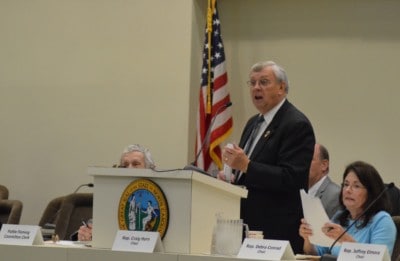
The effect of pollution on health has been well documented, but until recently, pollution was largely an environmental and health concern rather than an educational one. Now that is changing, thanks to new research on the impact of pollution on educational outcomes.
Claudia Persico, assistant professor in the Department of Public Administration and Policy at American University, presented Monday at N.C. State on her new research examining the effect of attending school close to Toxic Release Inventory sites (TRI), such as factories or manufacturing plants. She and coauthor Joanna Venator found that Florida students attending school within one mile of a TRI had lower test scores and were more likely to be suspended compared to students at schools farther away. In addition, schools closer to a TRI were more likely to receive a lower school performance grade under Florida’s accountability system. These results suggest efforts to improve air quality within schools and locate new schools away from pollution-emitting sites would improve student outcomes.
Toxic Release Inventory sites: More common than you think
“You can think of TRI sites [as] predominantly factories or federal facilities,” said Persico in an interview. “They’re kind of a cluster of different types of facilities that emit pollution that we think is especially toxic — what we call airborne toxic.”
Toxic Release Inventory sites are common throughout the United States. According to Persico and Venator, two-thirds of the U.S. population live within three miles of a TRI site, and almost 22% of public schools were located within one mile of a TRI site in 2016. In Florida, schools that serve predominantly students of color and lower income students were disproportionately located near TRI sites.
Part of the reason so many schools are located close to TRI sites, Persico said, is due to the fact that the land around these sites is generally cheaper.
“We know that pollution affects housing values and affects land values, and budget-conscious districts might choose to locate their schools on reasonably priced land, because of budget constraints and other types of things,” Persico said.
In 2011, the Environmental Protection Agency implemented the Mercury and Air Toxics Standards to reduce air pollution, but these rules were overturned by the U.S. Supreme Court in 2015 due to an insufficient cost-benefit analysis. Persico sees her research as helping illuminate the true cost of pollution by showing not just the impact on health but the impact on educational outcomes.
The effect of pollution
Persico and Venator used Florida student-level data from 1996 to 2012 to examine test scores, attendance, and suspension rates in schools located both within one mile of a TRI site and between one to two miles of a TRI site. They use Florida data because the state is largely demographically representative of the United States and has been collecting test scores for years, allowing the researchers to follow students longitudinally.
The researchers use a difference-in-differences experimental design to compare student outcomes at schools within one mile of a TRI site before and after the TRI site opened or closed to outcomes at schools located within one to two miles of the TRI site in the same zip code. Between 1999 and 2012, 304 sites started operating within a mile of public school and 378 TRI sites stopped operating within one mile of a public school. Over that time period, there were 600 public schools located within one mile of a TRI site and 604 public schools within one to two miles.
Persico explained they chose one to two miles because the type of air pollution emitted by TRI sites generally does not travel farther than a mile. However, due to wind patterns and other factors, Persico said their results probably underestimate the impact since students attending schools one to two miles from a TRI site may be exposed to some residual pollution.
The study finds that compared to students at schools within one to two miles of a TRI site, students at schools within one mile of a TRI site have lower test scores the year after a TRI site opens. They also find “suggestive evidence” that a TRI site opening impacts attendance and suspensions, although these results were not as strong as the effect on test scores. The effect on test scores was much stronger for younger children, and it was consistent across racial and ethnic groups.
How big is the effect on test scores? The researchers measure the effect in percentages of a standard deviation, which can be hard to interpret for the average person. So, Persico and Venator attempt to quantify the effect on test scores by calculating lifetime lost earnings due to lower test scores. They find that exposure to TRI pollution results in lifetime lost earnings of about $4,300 per student. This may not seem like much, especially over a person’s lifetime, but multiply that by the number of children attending schools near TRI sites, and it becomes a big cost.
“Given that 436,088 children in Florida ever attended school within one mile of an operating TRI site during this sample period, that implies $1,875,178,400 in lost lifetime earnings,” Persico and Venator write in the paper.
Researchers aren’t convinced as to how pollution impacts test scores. Persico identified two ways it could be impacting test scores: through increased absences caused by illness or through a direct impact on children’s brains and cognition. She noted that chronic air pollution has been linked to higher instances of dementia and that people are more likely to have a heart attack on days with higher pollution.
“The story I worry about is [pollution] directly affecting the brain because if that’s the case, and if there are longer-term effects, like if there is some type of neural degeneration going on, that could potentially affect children for a long time,” Persico said.
Implications for policymakers and school districts
These results may seem grim, but the good news is that policymakers and school district leaders can do something about it. Installing air filters in schools located near TRI sites is one way to reduce the effect of pollution in schools, Persico noted. Additionally, these results should be taken into consideration when building new schools.
“I think the cheapest thing to do is to stop locating schools near sources of pollution to begin with,” Persico said. “When we’re choosing new school locations, choosing ones that are farther away from sources of pollution seems to be one of the least costly things to do.”
Another option she mentioned is to regulate the amount of air pollution allowed within one mile of a school, or introduce zoning laws that prohibit TRI sites from opening within one mile of a school.
All in all, Persico said the most important result of this research is that people are more aware of the cost of pollution and take that into account when deciding where to locate factories and other polluting sites.
“This research is really also trying to voice this concern that locating a school [close to pollution] is much more costly than we realize,” she said, “to society, to the children attending the school, to future wages, employment prospects, and all sorts of things.”



